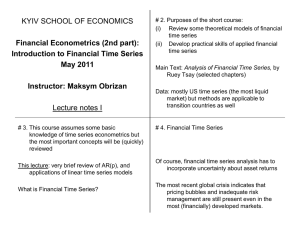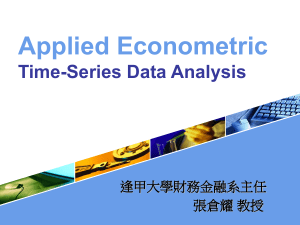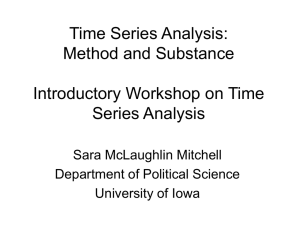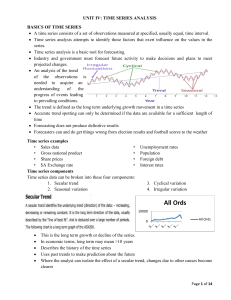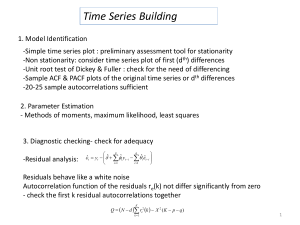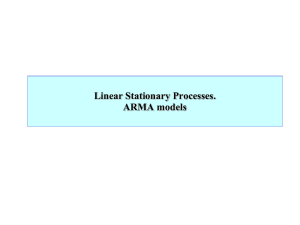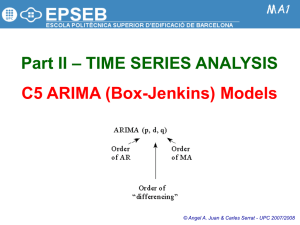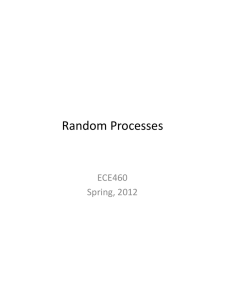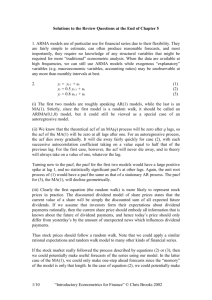Slides - Engineering
advertisement
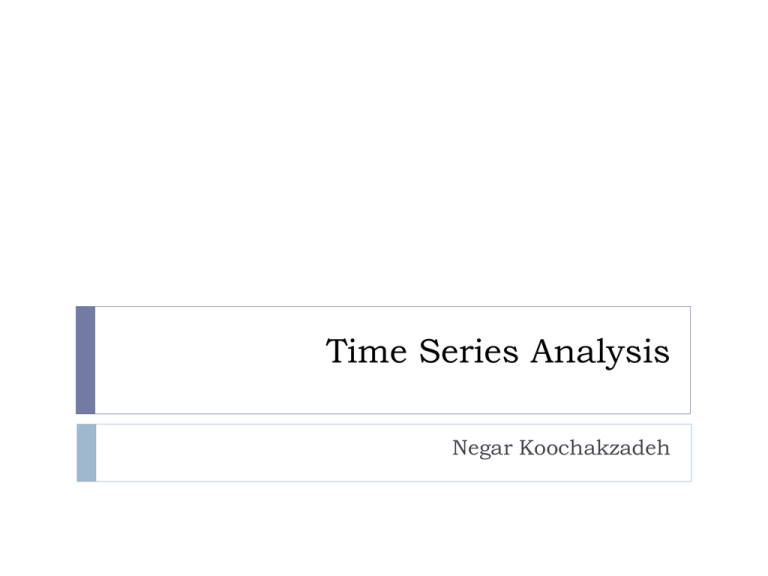
Time Series Analysis
Negar Koochakzadeh
Outline
Introduction:
Stationary / Non-stationary TS Data
Existing TSA Models
Example 1: International Airline Passenger
Example 2&3: Energy Load Prediction
Time Series Data Mining
AR (Auto-Regression)
MA (Moving Average)
ARMA (Auto-Regression Moving Average)
ARIMA (Auto-Regression Integrated Moving Average)
SARIMA (Seasonal ARIMA)
Examples
Time Series Data
Time Series Classification (SVM)
Example
Example 4: Stock Market Analysis
Time Series Data
In many fields of study, data is collected from a system
over time.
This sequence of observations generated a time series:
Examples:
Closing prices of the stock market
A country’s unemployment rate
Temperature readings of an industrial furnace
Sea level changes in coastal regions
Number of flu cases in a region
Inventory levels at a production site
Temporal Behaviour
Most physical processes do not change quickly, often
makes consecutive observation correlated.
Correlation between consecutive observation is called
autocorrelation.
Most of the standard modeling methods based on the
assumption of independent observations can be
misleading.
We need to consider alternative methods that take into
account the serial dependence in the data.
Stationary Time Series Data
Stationary time series are characterized by having a
distribution that is independent of time shifts.
Mean and variance of these time series are constants
If arbitrary snapshots of the time series we study exhibit
similar behaviour in central tendency and spread, we can
assume that the time series is indeed stationary.
Stationary or Non-Stationary?
In practice, there is no clear demarcation line between a
stationary and a non-stationary process.
Some methods to identify:
Visual inspection
Using intuition and knowledge about the process
Autocorrelation Function (ACF)
Variogram
Visual Inspection
A properly constructed graph of a time series can
dramatically improve the statistical analysis and accelerate
the discovery of the hidden information in the data.
“You can observe a lot by watching.” This is particularly
true with time series data analysis! [Yogi Berra, 1963]
Intuition and knowledge Inspection
Does it make sense...
for a tightly controlled chemical process to exhibit similar
behaviour in mean and variance in time?
to expect the stock market out it “to remain in
equilibrium about a constant mean level”
The selection of a stationary or non-stationary model
must often be made on the basis of not only the data but
also a physical understanding of the process.
Autocorrelation Function (ACF)
Autocorrelation is the crosscorrelation of a time series data with
itself based on lag k
𝐴𝐶𝐹(𝐾) = 𝐶𝑜𝑟𝑟(𝑍𝑡 , 𝑍𝑡−𝐾 )
ACF summarizes as a function of k,
how correlated the observations that
are k lags apart are.
If the ACF does not dampen out then
the process is likely not stationary
(If a time series is non-stationary, the
ACF will not die out quickly)
Variogram
The Variogram Gk measures the variance of differences k
time units apart relative to the variance of the differences
one time unit apart
𝑉 { 𝑍𝑡+𝑘 − 𝑍𝑡 }
𝐺𝑘 =
𝑉 { 𝑍𝑡+1 − 𝑍𝑡 }
For stationary process, Gk when plotted as a function of
k will reach an asymptote line. However, if the process is
non-stationary, Gk will increase monotonically.
Modeling and Prediction
“If we wish to make predictions, then clearly we must assume
that something does not vary with time.” [Brockwell and
Davis, 2002]
Let’s try to predict and build a model for our time series
process based on:
Serial Dependency
Leading Indicators
Disturbance
True disturbances caused by unknown and/or uncontrollable
factors that have direct impact on the process.
It is impossible to come up with a comprehensive
deterministic model to account for all these possible
disturbances, since by definition they are unknown.
In these cases, a probabilistic or stochastic model will be more
appropriate to describe the behaviour of the process.
Notations
∇𝑍𝑡 = 𝑍𝑡 − 𝑍𝑡−1
∇2 𝑍𝑡 = ∇ ∇𝑍𝑡 = 𝑍𝑡 − 2𝑍𝑡−1 + 𝑍𝑡−2
∇𝑠 𝑍𝑡 = 𝑍𝑡 − 𝑍𝑡−𝑠
𝑍𝑡 = 𝑍𝑡 − 𝜇
𝑍𝑡−𝑠 (𝑘) = 𝑓𝑜𝑟𝑐𝑎𝑠𝑡 𝑜𝑓 𝑍𝑡−𝑠+𝑘 𝑎𝑡 𝑡𝑖𝑚𝑒 𝑡 − 𝑠
Backshift Operator
𝐵𝑍𝑡 = 𝑍𝑡−1
∇𝑍𝑡 = (1 − 𝐵)𝑍𝑡
∇ ∇𝑍𝑡
= (1 − 𝐵2 )𝑍𝑡
∇𝑠 𝑍𝑡 = (1 − 𝐵)𝑠 𝑍𝑡
Auto-Regressive Models
AR(P)
𝑍𝑡 = 𝜑1 𝑍𝑡−1 + . . . + 𝜑1 𝑍𝑡−𝑝 + 𝑎𝑡
Where at is an error term (called white error) assumed
to be uncorrelated with zero mean and constant
variance.
The random error at cannot be observed. Instead we
estimate it by using the one-step-ahead forecast error
𝑎𝑡 = 𝑍𝑡 − 𝑍𝑡−1 (1)
The regression coefficients 𝜑𝑖 , i = 1, ... , p, are parameters
to be estimated from the data
Moving Average
Current and previous disturbances affect the value.
We have a sequence of random shocks bombarding the
system and not just a single shock.
MA(q)
𝑍𝑡 = 𝑎𝑡 − 𝜃1 𝑎𝑡−1 − . . . − 𝜃𝑞 𝑎𝑡−𝑞
Uncorrelated random shocks with zero mean and
constant variance
The coefficients 𝜃𝑖 , i = 1, ... , q are parameters to be
determined from the data
Auto-Regressive Moving Average
ARMA(p,q)
𝑍𝑡 = 𝜑1 𝑍𝑡−1 + . . . + 𝜑1 𝑍𝑡−𝑝 + 𝑎𝑡 − 𝜃1 𝑎𝑡−1 − . . . − 𝜃𝑞 𝑎𝑡−𝑞
Typical stationary time series models come in three
general classes, auto-regressive (AR) models, moving
average (MA) models, or a combination of the two
(ARMA).
Identifying appropriate Model
The ACF plays an extremely crucial role in the
identification of time series models
The identification of the particular model within ARMA
class of models is determined by looking at the ACF and
PACF.
Partial Autocorrelation Function (PACF)
Partial Autocorrelation is the partial cross-correlation of a
time series data with itself based on lag k
Partial correlation is a conditional correlation:
It is the correlation between two variables under the assumption
that we know and take into account the values of some other set of
variables
How Zt and Zt-k are correlated taking into account how both
Zt and Zt-k are related to Zt-1 , Zt-2 , ... , Zt-k+1
The kth order PACF measure correlation between Zt and Zt+k
after adjustments have been made for the intermediate
observations Zt-1 , Zt-2 , ... , Zt-k+1
𝑃𝐴𝐶𝐹(𝐾) = 𝐶𝑜𝑟𝑟 (𝑍𝑡 − 𝑃𝑡,𝑘 (𝑍𝑡 ) , 𝑍𝑡−𝐾 − 𝑃𝑡,𝑘 (𝑍𝑡−𝐾 ))
where 𝑃𝑡,𝑘 (𝑥) denotes the projection of x onto the space spanned by
Zt-1 , Zt-2 , ... , Zt-k+1
ARMA Model identification from ACF and PACF
AR(p)
ACF
PACF
Infinite damped
exponentials and/or
damped sine waves;
Tails off
Finite; cuts off
after p lags
Source: Adapted from BJR
MA(q)
ARMA(p, q)
Finite; cuts off
after q lags
Infinite damped
exponentials and/or
damped sine waves;
Tails off
Infinite damped
exponentials and/or
damped sine waves;
Tails off
Infinite damped
exponentials and/or
damped sine waves;
Tails off
Examples
Models for Non-Stationary Data
Standard autoregressive moving average (ARMA) time
series models apply only to stationary time series.
The assumption that a time series is stationary is quite
unrealistic. (Stationary is not natural!)
For a system to exhibit a stationary behaviour, it has to be
tightly controlled and maintained in time.
Otherwise, systems will tend to drift away from
stationary
Converting Non-Stationary Data to Stationary
More realistic is to claim that the changes to a process, or
the first difference, form a stationary process.
And if that is not realistic, we mat try to see if the
changes of the changes, the second difference, form a
stationary process.
If that is the case, we can then model the changes, make
forecasts about the future values of these changes, and
from the model of the changes build models and create
forecasts of the original non-stationary time series.
In practice, we seldom need to go beyond second order
differencing.
Auto Regressive Integrated Moving Average
(ARIMA)
In the case of non-stationary data, differencing before we
use the (stationary) ARMA model to fit the (differenced)
data wt = ∇𝑍𝑡 = 𝑍𝑡 − 𝑍𝑡−1 is appropriate.
Because the inverse operation of differencing is summing
or integrating, an ARMA model applied to d differenced
data is called an autoregressive integrated moving average
process, ARIMA (p, d, q).
𝑤𝑡 = ∇𝑑 𝑍𝑡
In practice, the orders p, d, and q are seldom higher than
2.
Stages of the time series model building
process using ARIMA
Consider a general
ARIMA Model
Identify the appropriate
degree of differencing if needed
Using ACF and PACF,
find a tentative model
Estimate the parameters of
the model using
appropriate software
Perform the residual
analysis.
Is the model adequate?
Start forecasting
Model Evaluation
Once a model has been fitted to the data, we process to
conduct a number of diagnostic checks.
If the model fits well, the residuals should essentially
behave like white noise.
In other words, the residuals should be uncorrelated with
constant variance.
Standard checks are
to compute the ACF
and PACF of the residuals.
If they appear in the
confidence interval there is
no alarm indications that
the model does not fit well.
Exponentially Weighted Moving Average
Special case of ARIMA model: EWMA
𝑍𝑡 = (1 − 𝜃)(𝑍𝑡−1 + 𝜃𝑍𝑡−2 + 𝜃 2 𝑍𝑡−3 +. . . ) + 𝑎𝑡
|𝜃| < 1
Unlike a regular average that assigns equal weight to all
observation, an EWMA has a relatively short memory that
assigns decreasing weights to past observations.
EWMA made practical sense that a forecast should be a
weighted average that assigns most weight to the most
immediate past observation, somewhat less weight to the
second to the last observation, and so on.
It just made good practical sense.
Seasonal Models
For ARIMA models, the serial dependence of the current
observation to the previous observations was often
strongest for the immediate past and followed a decaying
pattern as we move further back in time.
For some systems, this dependence shows a repeating,
cyclic behaviour.
This cyclic pattern or as more commonly called seasonal
pattern can be effectively used to further improve the
forecasting performance.
The ARIMA models are flexible enough to allow for
modeling both seasonal and non-seasonal dependence.
Example 1: International Airline Passengers
Trend and Seasonal Relationship
Two relationship going on simultaneously:
Between observations for successive months within the same
year
Between observation for the same month in successive years.
Therefore, we essentially need to build two time series
models, and then combine the two.
If the season is s period long, in this example s = 12
months, then observation that are s time intervals apart
are alike.
Pre-Processing
Log Transformation
Apply Differencing on Seasonal Data
For seasonal data, we may need to use not only regular
difference ∇𝑍𝑡 but also a seasonal difference ∇𝑠 𝑍𝑡 .
Sometimes, we may even need both (e.g., ∇∇𝑠 𝑍𝑡 ) to obtain
an ACF that dies out sufficiently quickly.
Investigate ACFs
Only the last one (combination of regular difference and
seasonal difference) is stationary:
Model Identification
ACF seems to cut off after the first one (in k=12).
This is a sign of a Moving Average Model applied to the 12month seasonal pattern.
Second, look for patterns between
successive months
ACF seems to cut off after the first one
First order MA term in the regular model
ACF
Identifying stationary seasonal models is a modification of
the one used for regular ARMA time series models where
the patterns of the sample ACF and PACF provide
guidance.
First, look for similarities that are 12 lags apart.
PACF
Model Evaluation
ACF of the residuals after fitting a first order SMA model
to ∇∇12 𝑍𝑡 :
We see that the ACF shows a significant negative spike at
lag 1, indicating that we need an additional regular moving
average term
ARIMA (p,d,q)*(P,D,Q)12
𝑊𝑡 = 𝑏𝑡 − Θ1 bt−12
𝑏𝑡 = 𝑎1 − 𝜃1 𝑎𝑡−1
∇∇12 𝑍𝑡 = 𝑎1 − 𝜃1 𝑎𝑡−1 − Θ1 (𝑎𝑡−12 − 𝜃1 𝑎𝑡−13 )
𝑍𝑡 − 𝑍𝑡−1 − 𝑍𝑡−12 + 𝑍𝑡−13 = 𝑎1 − 𝜃1 𝑎𝑡−1 − Θ1 𝑎𝑡−12 − Θ1 𝜃1 𝑎𝑡−13
Example 2: Energy Peak Load Prediction
The hourly peak load follows
a daily periodic pattern
Covert peak load
values into ∇24 𝑍𝑡 and then
apply ARMA
ACF
S=24 hours
PACF
Example 3: Energy Load Prediction
Daily, weekly, and
monthly periodic patterns
Exogenous Variables
(Temperature)
They proposed to apply Periodic Auto-Regression (PAR)
* An auto-regression is periodic when the parameters
are allowed to vary across seasons.
Example 3 (cont’d)
Proposed model template:
Seasonality varying
intercept term
Dummy variable
for weekly seasonal
Dummy variable
for monthly seasonal
Exogenous variable
for temperature
sensitivity
Time Series Data Mining
Using Serial Dependency of forecasting variable to build
the training set.
Leading indicators might exhibit similar behaviour to
forecasting variable
The important task is to find out whether there exists a lagged
relationship between indicators and predicted variable
If such a relationship exists, then from the current and past
behaviour of the leading indicators, it may be possible to
determine how the sales will behave in the near future.
Time Series SVM
Optimization problem
in SVM:
Error in SVM:
Error in Modified SVM:
Example 4: Stock Market Analysis
Portfolio optimization is the decision process of asset
selection and weighting, such that the collection of assets
satisfies an investor’s objectives
Bloomberg
Mnemonic
Serial dependency or Lagged
Relationship between
stock performance and
financial indicators from
the companies.
Description
Indicates how much out of every dollar of
sales, the company actually keeps in earning :
Net Income / Revenue
Quantifies the companies success of effort to
RETURN_
earn a profit with respect to its total asset:
ON_ASSET
Net Income / Total Assets
Quantifies the companies success of effort to
RETURN_ON_CAP earn a profit with respect to its capital:
Net Income / (Total Assets - Current Liabilities)
Quantifies the ratios of Return On Asset to
Return On Equity (ROE: Net Income as a
ROA_TO_ROE
percentage of shareholders' equity):
Shareholder's Equity / Total Assets
Indicates Return On Asset calculated based on
the last line of the company's income
ROA_BASED_
statement. This reflects the fact that all
ON_BOTTOM_EPS
expenses have already been taken out of
revenues, and there is nothing left to subtract.
Indicates Revenue with respect to each share
price. Revenue is the income that a company
REVENUE_PER_SH receives from its normal business activities,
usually from the sale of goods and services to
PROF_MARGIN
Stock Ranking
Learn relationship between stocks’ current features and
their future rank score. (Lagged Relationship)
By Applying modified version of SVM Rank Algorithm for
time series based on exponential weighted error.
t1
t0
tk
t2
tc
ΔtS
Δtr
3
S2 0.2 0.3
0.6
1
S2 0.5 0.6
S3 0.4 0.5
2
S3 0.7 0.1
0.4
2
S3 0.1 0.7
0.2
Training Set
3
S1 0.5 0.9
0.1
2
S2 0.8 0.2
0.7
1
S3 0.7 0.7
f2
0.4
2
S1 0.4 0.3
0.4
2
1
0.5
1
S2 0.5 0.9 -0.7
3
3
0.1
3
S3 0.7 0.2
1
2
f1
Target
Rank Score
Predicted
Rank Score
S2 0.3 0.1 -0.1
f2
future ROI
S1 0.4 0.2 -0.3
f1
Stock Name
1
f2
Target
Rank Score
0.6
f1
future ROI
S1 0.3 0.7
S1 0.5 0.9
f1
Stock Name
1
f2
Target
Rank Score
Target
Rank Score
0.5
f1
future ROI
f2
future ROI
Stock Name
Target
Rank Score
Stock Name
future ROI
Stock Name
…
0.6
Testing Set
References
[1] Søren Bisgaard and M. Kulahci, TIME SERIES ANALYSIS AND FORECASTING
BY EXAMPLE: A JOHN WILEY & SONS, INC., 2011.
[2] Rayman Preet Singh, Peter Xiang Gao, and Daniel J. Lizotte, "On Hourly
Home Peak Load Prediction," in IEEE SmartGridComm, 2012.
[3] Marcelo Espinoza, Caroline Joye, Ronnie Belmans, and Bart De Moor,
"Short-Term Load Forecasting, Profile Identification, and Customer
Segmentation: A Methodology Based on Periodic Time Series," Power
Systems, vol. 20, pp. 1622-1630, 2005.
[4] F. E. H. Tay and L. Cao, "Modified support vector machines in financial time
series forecasting," Neurocomputing, vol. 48, pp. 847-861, 2002
Questions?
